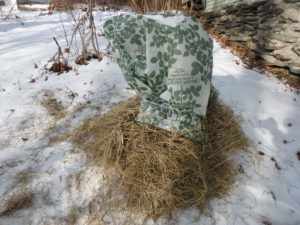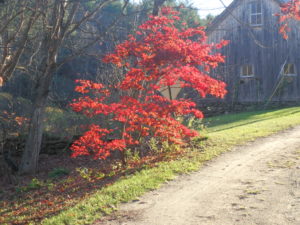How Will Cold Weather Affect Our Gardens?
We’ve had some very cold weather recently. And although I hear gardeners at the post office or country store complaining about the cold, the weather has been normal for this time of year. It’s January, after all, and it’s supposed to be cold. It’s even good to have some deep cold.
I live in a Zone 4 location. That means that during an average winter the temperatures will dip down to between minus 20 and minus 30 degrees. So far I’ve recorded temps in the low twenties – below zero. Balmy? No, but still in the normal range for my climatic zone.
Trees, shrubs and perennial flowers can be damaged or killed if the temperatures get too cold, especially if the temperature stays low for a number of days, or if there is a strong cold wind. Snow cover is good, as it serves as a blanket over the roots. We’ve had a long run of cold days, and we’re all shivering a little, even our plants.
The US Department of Agriculture rates each state with a zone depending on averages. These zones reflect the average extreme minimum temperature over a 10 year period as follows: Zone 3: -40; Zone 4: -30; Zone 5: -20; Zone 6: -10; Zone 7: 0 degrees Fahrenheit. If you don’t know your climatic zone, Mrs. Google will show you a Plant Hardiness Zone map covering your area, just ask her.
So what is good about cold times? As my late sister, Ruth Anne Mitchell, used to say, “Thirty below keeps out the riff-raff.” By that she meant invasive pests like the wooly adelgid that devastates Canadian hemlocks in southern New England. As the climate warms, they have been slowly moving northward. This year might knock back pest numbers.
Late blight, a fungal pest which can devastate tomatoes and potatoes, and can overwinter in Georgia but will not survive in New England if the soil freezes. Of course if we have a deep snow cover, the soil will not freeze more than a few inches. That is why you shouldn’t let “volunteer” potato plants remain in the garden next spring if you had any late blight last summer. Late blight can winter-over in potatoes, but not in foliage. Unfortunately early blight will survive our cold winters, and comes back every year.
I am sometimes grow perennial flowers that are rated for use only in warmer zones. I have plenty of Zone 5 plants, and even try some that are only rated for Zone 6. If they are well established and have the growing conditions that make them do well, they will often survive for several years before a very cold winter like this one does them in. But by then I’ve had several years of enjoyment.
Very few perennials last forever. Only peonies really can be expected to last for the rest of your life. I have one from my grandmother Lenat’s garden – and she died in 1953. My mom grew it, and then gave me a piece of it in the 1980’s. I hope one of my grandchildren will want it when I die.
You can take measures to protect shrubs and small trees from cold weather, but I don’t know that it really makes much difference. I know some people wrap their tender shrubs with burlap or synthetic fabric in effort to help them survive the winter.Last winter I wrapped a 2-year old kousa dogwood (Zone 5) with fabric. I did not get any blossoms, but there was no winter dieback from the cold. This fall I did not bother wrapping my kousa dogwood, but I did mulch the roots well with bark chips to protect the roots. It may just be too young to blossom, or need more sunshine.
I have a Japanese red maple (Acer palmatum) that is rated as a Zone 5 plant, but is now over 40 years old. When it was a young plant it often lost branches (or the tips of branches) after cold winters. I have never done anything to protect it from the cold, and I would rate it as a Zone 4 plant. The mother plant I Connecticut at my parents’ home is majestic. Here the cold has kept it small.
Roses are often susceptible to cold weather, but again, I have Zone 5 roses that have survived here. I cut them back in the spring to remove blackened or brown branches killed by the cold. Some years, particularly for luscious new roses, I use cut branches of evergreens to protect them. And some roses I buy and use as annuals.
Instead of putting your Christmas tree on the curb to be hauled away by the city, cut off all the branches and use them around roses or other tender small shrubs. I stand up the branches leaning them against a rose, forming a teepee. Does this really make a difference? I don’t know. It will break the wind, but the temperature can’t be much different.
I love winter and I cross-country ski even when the temperatures are in the single digits. I don’t fear for my plants when we have a cold snap. After all, if something dies, it opens up a new place in the garden for an exciting new plant. So stop your grumbling – unless it keeps you warm!
Read Henry’s blog posts at https://dailyuv.com/




